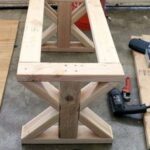Refinishing shellac woodwork can be a rewarding and transformative process, bringing back the natural beauty of the wood and enhancing its overall appeal. Shellac woodwork is a type of finish that has been used for centuries to protect and beautify wood surfaces. In this article, we will explore the steps and techniques for refinishing shellac woodwork, from preparing the surface to applying a new finish and adding decorative touches.
Shellac woodwork is known for its high-gloss finish and warm color tones, making it a popular choice for furniture, trim, and other wooden surfaces. Over time, however, shellac finishes can become worn or damaged, leading to a dull and lackluster appearance. Refinishing shellac woodwork is essential to restore its original charm and elegance, prolonging the lifespan of the furniture or decorative elements in your home.
To successfully refinish shellac woodwork, it is important to have the right tools and materials on hand. From sandpaper and paint scrapers for removing old finishes to protective gloves and new shellac finish for application, having the necessary supplies is crucial for achieving a professional result.
In the following sections, we will discuss each step in detail, providing guidance on how to prepare the woodwork, apply the new finish, use wood conditioner, buff and polish the surface, add finishing touches, as well as maintain the refinished shellac woodwork for lasting beauty.
Tools and Materials Needed for Refinishing
Refinishing shellac woodwork can be a rewarding and cost-effective way to breathe new life into old furniture or interior wood surfaces. Before getting started, it’s important to gather the necessary tools and materials for the refinishing process. By having everything on hand, you can ensure a smooth and successful project.
List of Required Tools
To refinish shellac woodwork, you will need a few essential tools. These include sandpaper in various grits to remove the old finish and smoothen the surface, a paint scraper to carefully scrape off any stubborn remnants of shellac, and protective gloves to shield your hands from chemicals and sharp edges. Additionally, having a clean cloth for wiping down the woodwork between steps is crucial for achieving a polished finish.
Mention of Materials
In addition to the necessary tools, obtaining the right materials is equally important for refinishing shellac woodwork. One essential item is the shellac finish itself, which can be purchased in liquid form for easy application. Wood conditioner is another crucial material as it helps prepare the surface for the new finish by improving its absorption and overall appearance. Lastly, having a quality brush or applicator for applying the shellac finish evenly is key to achieving professional-looking results.
Once you have gathered all of these tools and materials, you will be ready to move on to preparing the woodwork for refinishing. Following these steps will ensure that you are well-equipped to navigate through each stage of restoring your shellac woodwork with confidence.
Preparing the Woodwork for Refinishing
Before applying a new shellac finish to woodwork, it is crucial to properly prepare the surface to ensure a smooth and even coating. The process of refinishing shellac woodwork begins with removing the old finish and cleaning the surface. This section will provide detailed steps on how to prepare the woodwork for refinishing, ensuring optimal results.
Removing Old Shellac Finish
The first step in preparing woodwork for refinishing is to remove the old shellac finish. This can be done using sandpaper and a paint scraper. Begin by lightly sanding the surface with fine-grit sandpaper to remove the top layer of shellac.
Be sure to work in the direction of the wood grain to avoid causing any damage to the surface. Once the majority of the old finish has been removed, use a paint scraper to gently scrape away any remaining bits of shellac. Take care not to apply too much pressure, as this could lead to scratching or gouging the wood.
Cleaning the Surface
After removing the old shellac finish, it is essential to thoroughly clean the woodwork to eliminate any dust or debris that may have accumulated during the sanding and scraping process. Use a clean, dry cloth to wipe down the surface and remove any loose particles.
For more stubborn residue, consider using a mild wood cleaner or denatured alcohol to ensure that the surface is completely clean before applying a new finish. This meticulous cleaning process will help ensure that the new shellac finish adheres properly and produces an attractive result.
Protecting Surrounding Areas
Additionally, it is important to protect surrounding areas from dust and debris generated during preparation stage by covering or taping off nearby furniture, walls, or floors while working on refinishing shellac woodwork.
By following these steps for preparing woodwork for refinishing, individuals can effectively restore their shellac woodwork’s natural beauty and enhance its durability.
Applying the New Shellac Finish
When it comes to refinishing shellac woodwork, applying the new shellac finish is a crucial step in the process. Whether you are restoring a vintage piece of furniture or refinishing wood trim in your home, knowing how to properly apply the shellac finish will help you achieve a beautiful and long-lasting result. Below are some detailed instructions on how to apply the new shellac finish evenly and effectively:
Steps for Applying Shellac Finish
- Prepare the work area by ensuring good ventilation and protecting surrounding surfaces from potential drips.
- Using a clean brush or cloth, apply the first coat of shellac finish in smooth, even strokes, following the grain of the wood.
- Allow the first coat to dry completely before lightly sanding the surface with fine-grit sandpaper to remove any imperfections.
- Apply additional coats of shellac finish as needed, taking care to sand between each coat for optimal adhesion and smoothness.
- After the final coat has dried, gently buff the surface with a soft cloth or fine steel wool to achieve a smooth and glossy finish.
Tips for Achieving an Even Finish
- Work in small sections to ensure thorough coverage without over-applying the shellac finish.
- Avoid applying too much pressure when brushing on the shellac to prevent streaks or uneven application.
- If using a cloth for application, be sure to wring out excess shellac and work quickly to prevent drying lines or patches.
By following these steps and tips for applying shellac finish, you can transform dull or worn woodwork into a stunning focal point in your home. The key is to take your time and pay attention to detail, as this will ensure a professional-quality result that showcases the natural beauty of the wood.
Remember that proper application of shellac finish is essential for achieving a durable and attractive result when refinishing shellac woodwork. Taking your time and following these guidelines will help you achieve a smooth, glossy finish that highlights the unique characteristics of your woodwork while providing long-lasting protection.
Using Wood Conditioner
When refinishing shellac woodwork, one important step in the process is using a wood conditioner. This is particularly crucial when working with porous or open-grained wood, as it helps to ensure an even application of the new finish and prevents splotchy or uneven results. Wood conditioner also helps to enhance the natural color and grain of the wood, resulting in a more attractive and professional-looking finish.
To use wood conditioner effectively, begin by sanding the woodwork to prepare it for the new finish. Once the surface is smooth and free of old finish or debris, apply the wood conditioner evenly using a brush or clean cloth. Allow the conditioner to penetrate the wood according to the manufacturer’s instructions, usually around 15-30 minutes depending on the type of conditioner used.
After allowing the wood conditioner to penetrate and dry, you can proceed with applying the new shellac finish. The use of wood conditioner not only helps to achieve a smoother and more uniform appearance once the new finish is applied but also contributes to better adhesion and durability of the final result. By taking this extra step in refinishing shellac woodwork, you can ensure a beautiful and long-lasting outcome.
| Wood Conditioner Benefits | How to Apply |
|---|---|
| Enhances natural color and grain | Apply evenly with brush or cloth |
| Promotes even application of new finish | Allow penetration for 15-30 minutes |
| Improves adhesion and durability of new finish | Smooth surface for more attractive result |
Buffing and Polishing
After successfully applying the new shellac finish to your woodwork, the next crucial step in the refinishing process is buffing and polishing. This step is essential for achieving a smooth and glossy surface that truly enhances the natural beauty of the wood.
Buffing removes any imperfections or rough spots in the finish, while polishing adds a layer of shine that highlights the richness of the wood grain. In this section, we will provide detailed instructions on how to properly buff and polish your shellac woodwork to achieve professional-looking results.
To begin the buffing process, you will need a soft cloth or pad made specifically for this purpose. Gently rub the cloth or pad over the newly applied shellac finish in circular motions. This action helps to even out any uneven areas and create a consistent sheen across the entire surface. Be sure to apply gentle pressure to avoid scratching or damaging the finish.
Once you have completed buffing, it’s time to move on to polishing. Using a clean, dry cloth, apply a small amount of shellac wax polish to the woodwork. In circular motions, gently work the polish into the surface until it begins to shine.
For larger areas, an electric buffer can be used for more efficient and consistent polishing. Take care not to apply too much pressure during this process, as excessive force can lead to streaks or smudges in the finish.
By following these steps for buffing and polishing your refinished shellac woodwork, you can achieve a stunning end result that showcases the natural beauty of the wood. Remember that patience is key during this stage, as rushing through buffing and polishing can result in an uneven or lackluster finish. With proper care and attention, your efforts will be rewarded with a beautifully restored piece of woodwork that you can admire and enjoy for years to come.
At this point, you have successfully completed all necessary steps for refinishing your shellac woodwork. It’s time to take a moment to admire your hard work and appreciate the transformed appearance of your once tired or worn-out pieces of furniture or trim.
Whether it’s a family heirloom or a newly acquired antique find, taking pride in knowing how to refinish shellac woodwork is incredibly rewarding. Keep in mind that regular maintenance and care of your refinished woodwork will ensure its longevity and continued beauty for many years ahead.
Finishing Touches
After successfully refinishing your shellac woodwork, you may want to consider adding some decorative details or accents to enhance its overall appearance. This final step can truly elevate the look of the woodwork and give it a unique touch.
One option is to add decorative trim or molding to the edges of the woodwork, which can provide an elegant and polished finish. Additionally, you may choose to incorporate stenciled designs or motifs onto the surface of the woodwork for a more personalized and artistic flair.
Another way to add finishing touches to your refinished shellac woodwork is to consider staining or painting certain areas of the wood. This can help create visual interest and highlight specific features of the piece. For example, staining particular sections of a wooden cabinet can create a beautiful contrast between different parts of the furniture. Similarly, using paint to add intricate designs or patterns can make the woodwork stand out as a stunning focal point in any room.
Lastly, when it comes to maintaining your refinished shellac woodwork, it’s important to follow proper care and maintenance routines. Regularly dusting and cleaning the surface with a gentle cleaner will help preserve its beauty over time. Additionally, applying a fresh coat of shellac finish every few years can further protect the wood and maintain its luster.
| Finishing Touch | Detail |
|---|---|
| Decorative Trim or Molding | Provide an elegant and polished finish |
| Staining or Painting | Create visual interest and highlight specific features |
| Maintenance | Regularly dusting and applying fresh coat of shellac finish every few years |
Conclusion
In conclusion, learning how to refinish shellac woodwork can be a rewarding and satisfying process. By understanding the tools and materials needed, preparing the woodwork, applying the new shellac finish, using wood conditioner, buffing and polishing, and adding finishing touches, you can achieve a beautifully restored piece of woodwork.
Taking the time to properly refinish shellac woodwork allows you to admire the natural beauty of the wood while extending its lifespan. By following the step-by-step instructions and utilizing the tips provided, you can ensure that your refinished shellac woodwork will shine with a smooth and glossy finish.
Ultimately, as you admire your refinished shellac woodwork, take pride in the work that has been done to restore its beauty. Whether it’s a piece of furniture or architectural woodwork in your home, knowing how to properly refinish shellac woodwork allows you to appreciate its original charm for years to come.
Frequently Asked Questions
How Do You Restore Old Shellac Finish?
Restoring an old shellac finish involves gently cleaning the surface with a mild solution of water and dish soap to remove dirt and grime. After that, you can use denatured alcohol to remove any existing wax or polish buildup before applying fresh shellac.
Can You Apply New Shellac Over Old Shellac?
Yes, you can apply new shellac over old shellac as long as the old shellac is in good condition. It’s important to clean the surface thoroughly before applying the new shellac to ensure proper adhesion and a smooth finish.
How Do You Maintain Shellac Finish on Wood?
To maintain a shellac finish on wood, it’s important to regularly dust and clean the surface with a soft cloth or duster to prevent dirt buildup. Avoid using harsh chemicals or excessive moisture, as these can damage the shellac finish. If needed, you can also apply a fresh coat of shellac to rejuvenate the finish and protect the wood.

Hi everyone! I’m a woodworker and blogger, and this is my woodworking blog. In my blog, I share tips and tricks for woodworkers of all skill levels, as well as project ideas that you can try yourself.





